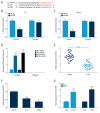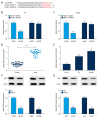Long Non-Coding RNA Taurine Upregulated Gene 1 (TUG1) Downregulation Constrains Cell Proliferation and Invasion through Regulating Cell Division Cycle 42 (CDC42) Expression Via MiR-498 in Esophageal Squamous Cell Carcinoma Cells
- PMID: 32139664
- PMCID: PMC7077061
- DOI: 10.12659/MSM.919714
Long Non-Coding RNA Taurine Upregulated Gene 1 (TUG1) Downregulation Constrains Cell Proliferation and Invasion through Regulating Cell Division Cycle 42 (CDC42) Expression Via MiR-498 in Esophageal Squamous Cell Carcinoma Cells
Abstract
BACKGROUND Esophageal squamous cell carcinoma (ESCC) is a malignant tumor of the gastrointestinal tract. Taurine upregulated gene 1 (TUG1), a long non-coding (lnc) RNA, also known as LIN00080 or TI-227H, was connected with the tumorigenesis of various diseases. Hence, we plumed the role and molecular mechanism of TUG1 in the progression of ESCC. MATERIAL AND METHODS Expression patterns of TUG1, microRNA-498 (miR-498), and cell division cycle 42 (CDC42) mRNA were assessed using quantitative real time polymerase chain reaction (qRT-PCR). The expression level of CDC42 protein was evaluated via western blot analysis. Cell proliferation and invasion were determined with Cell Counting Kit-8 (CCK-8) assay or Transwell assay. The relationship between miR-498 and TUG1 or CDC42 was predicted by online bioinformatics database LncBase Predicted v.2 or microT-CDS and confirmed through dual-luciferase reporter system or RNA immunoprecipitation assay (RIP). RESULTS TUG1 and CDC42 were upregulated while miR-498 was strikingly decreased in ESCC tissues and cells (P<0.0001). Besides, TUG1 suppression blocked the proliferation and invasion of ESCC cells (P<0.001). Importantly, TUG1 decrease restrained CDC42 expression via binding to miR-498 in ESCC cells. Also, the suppressive impacts of TUG1 silencing on the proliferation and invasion of ESCC cells were mitigated by miR-498 reduction. Meanwhile, the repression of proliferation and invasion induced by miR-498 elevation was weakened by CDC42 overexpression. CONCLUSIONS Inhibition of TUG1 hampered cell proliferation and invasion by downregulating CDC42 via upregulating miR-498 in ESCC cells. Thus, TUG1 might be an underlying therapeutic target for ESCC.
Conflict of interest statement
None.
Figures







Similar articles
-
LncRNA TUG1 promotes tumor growth and metastasis of esophageal squamous cell carcinoma by regulating XBP1 via competitively binding to miR-498.Neoplasma. 2020 Jul;67(4):751-761. doi: 10.4149/neo_2020_190805N717. Epub 2020 Apr 16. Neoplasma. 2020. PMID: 32305055
-
LncRNA TUG1 contributes to ESCC progression via regulating miR-148a-3p/MCL-1/Wnt/β-catenin axis in vitro.Thorac Cancer. 2020 Jan;11(1):82-94. doi: 10.1111/1759-7714.13236. Epub 2019 Nov 19. Thorac Cancer. 2020. PMID: 31742924 Free PMC article.
-
Knockdown of lncRNAXLOC_001659 inhibits proliferation and invasion of esophageal squamous cell carcinoma cells.World J Gastroenterol. 2019 Nov 14;25(42):6299-6310. doi: 10.3748/wjg.v25.i42.6299. World J Gastroenterol. 2019. PMID: 31754291 Free PMC article.
-
Molecular mechanisms of TUG1 in the proliferation, apoptosis, migration and invasion of cancer cells.Oncol Lett. 2019 Nov;18(5):4393-4402. doi: 10.3892/ol.2019.10848. Epub 2019 Sep 10. Oncol Lett. 2019. PMID: 31611948 Free PMC article. Review.
-
Role of long noncoding RNA taurine-upregulated gene 1 in cancers.Mol Med. 2021 May 26;27(1):51. doi: 10.1186/s10020-021-00312-4. Mol Med. 2021. PMID: 34039257 Free PMC article. Review.
Cited by
-
Cell division control 42 elevates during infliximab therapy, and its increment relates to treatment response in ulcerative colitis patients.J Clin Lab Anal. 2022 Jun;36(6):e24477. doi: 10.1002/jcla.24477. Epub 2022 May 9. J Clin Lab Anal. 2022. PMID: 35527674 Free PMC article.
-
RHO GTPase-Related Long Noncoding RNAs in Human Cancers.Cancers (Basel). 2021 Oct 27;13(21):5386. doi: 10.3390/cancers13215386. Cancers (Basel). 2021. PMID: 34771549 Free PMC article. Review.
-
The roles and mechanisms of the lncRNA-miRNA axis in the progression of esophageal cancer: a narrative review.J Thorac Dis. 2022 Nov;14(11):4545-4559. doi: 10.21037/jtd-22-1449. J Thorac Dis. 2022. PMID: 36524088 Free PMC article. Review.
-
The relationship of blood CDC42 level with Th1 cells, Th17 cells, inflammation markers, disease risk/activity, and treatment efficacy of rheumatoid arthritis.Ir J Med Sci. 2022 Oct;191(5):2155-2161. doi: 10.1007/s11845-021-02858-y. Epub 2021 Dec 2. Ir J Med Sci. 2022. PMID: 34859333 Free PMC article.
-
Roles of long non‑coding RNAs in esophageal cell squamous carcinoma (Review).Int J Mol Med. 2024 Aug;54(2):72. doi: 10.3892/ijmm.2024.5396. Epub 2024 Jul 4. Int J Mol Med. 2024. PMID: 38963019 Free PMC article. Review.
References
-
- Kollarova H, Machova L, Horakova D, et al. Epidemiology of esophageal cancer – an overview article. Biomed Pap Med Fac Univ Palacky Olomouc Czech Repub. 2007;151:17–20. - PubMed
-
- Siegel RL, Miller KD, Jemal A. Cancer statistics, 2015. Cancer J Clin. 2015;65:5–29. - PubMed
-
- Pennathur A, Gibson MK, Jobe BA, et al. Oesophageal carcinoma. Lancet. 2013;381:400–12. - PubMed
-
- Rustgi AK, El-Serag HB. Esophageal carcinoma. N Engl J Med. 2014;371:2499–509. - PubMed
-
- Zhu ZJ, Hu Y, Zhao YF, et al. Early recurrence and death after esophagectomy in patients with esophageal squamous cell carcinoma. Ann Thorac Surg. 2011;91:1502–8. - PubMed
MeSH terms
Substances
LinkOut - more resources
Full Text Sources
Miscellaneous

